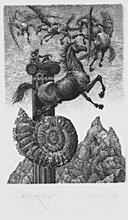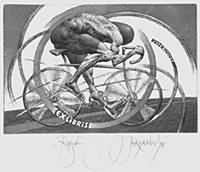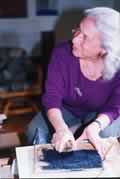
| Baren-suji is the newsletter of [Baren], The International Forum for Woodblock Printmaking. The official internet site of [Baren] is http://www.barenforum.org Baren-suji are the marks left by the baren when printing. Similarly, this newsletter assumes the role of recording the marks left by the woodblock printmakers that constitute [Baren]. Comments and contributions are welcomed. Please
contact:
Editor@mariarango.com Baren and The Encyclopedia of Woodblock Printmaking were created by David Bull in 1997 to promote the art of and share information about woodblock printmaking. Baren activities include an international discussion forum, a network of woodblock printmakers, workshops and get-togethers, and the very successful Exchange and Exhibition Programs. To join [Baren], simply point your browser to:
http://www.barenforum.org
and click on Administration Links. Be sure to read the FAQ's and Guidelines of the Forum. |
ISSUE 1: APRIL 2000
 NOTE! To return to this Table of Contents from anywhere in the Newsletter, just click on the barens scattered about. NOTE! To return to this Table of Contents from anywhere in the Newsletter, just click on the barens scattered about. SPRING FEATURES: Woodblock Prints in Bulgarian Printmaking, by Arafat Al-Naim Worthwhile Books on Printmaking, reviewed by Barbara Mason Members Meet in the Flesh: The 2000 L.A. Affair, by Bea Gold A Print Conservation Primer, by Jack Reisland
DEPARTMENTS: A Word from David Bull Editor's Notes Members' Comments Exchange & Exhibition News The Printmaker's World
Featured Member: Joe Sheridan by Wanda Robertson Woodcuts from All Over by Dimitris Grammatikopulos Members in the Spotlight Jeanne Norman Chase
April Vollmer and Sarah Houser Technicalities: Stages in Cutting a Block by David Bull Opportunities for Printmakers compiled by Maria Arango Sales and Trades Classified Advertisements
|
Copyright [Baren], 2000
Masthead design by John Amoss, Illustration (706) 549-4662
- e-mail: amoss@mindspring.com
No part of this newsletter may be reproduced without
permission from its publishers
To subscribe to
Baren-suji, change your subscription format, or unsubscribe, please go to http://barenforum.org/newsletter/newsletter_sign-up.html
 A WORD FROM DAVE
A WORD FROM DAVE
Welcome to the premier issue of 'Baren-Suji', the newsletter of
[Baren] the Internet Forum for Woodblock Printmaking.
Despite being the earliest of the printmaking techniques, woodblock
printmaking has for many years been considered a kind of 'poor relation' among
the printmaking family. For some, it is 'too simple'; for others, it is 'too
difficult'. But despite its lack of 'status', it persistently refuses to slink
away in shame and leave the stage to the other, more popular members of the
family.
Time and time again over the centuries it has come storming back, each time
returning with a fresh new face and a fresh new way of looking at the world.
The last time this happened was nearly a century ago, and we are long overdue
for another 'round'. But this time, with the internet here to encourage and
accelerate communication between printmakers around the world, the 'fresh
face' has a distinctly international appearance.
The [Baren] group is an important part of this newest awakening of the old
art of woodblock printmaking. It has a wonderfully healthy mix of professional
and amateur artists, of young ones and old ones, and what is best of all, it
is a blend of printmakers from all parts of the globe, not any one
particular culture. This practically ensures that the work it
produces will have interest and vitality.
It is not an 'academic' group in any way shape or form, and this is one of
its greatest strengths. It has no curriculum and no 'goals'; it lives with
only one motivation - the passion that its members bring to their art.
Over a hundred and fifty years ago, the French writer Leon de Labord wrote:
"Art (should not be) a rare plant artificially cultivated in a
greenhouse and which would die outdoors; art should be a vigorous and hardy
tree which blossoms in the sun, which drinks the night dew, and according to
the seasons, is covered with foliage, fruits and flowers."
Well
said Mssr. Labord! So here we are - it's spring again in the
world of woodblock printmaking! We hope you enjoy viewing and reading
about some of our 'blossoms', and look forward to many years of enjoying the
fine fruit!
David Bull
Founder, [Baren] forum for
woodblock printmaking.
 EDITOR'S NOTES
EDITOR'S NOTES

Contributed by John Ryrie |
Welcome all to the first issue of this newsletter. Our first aim was to bring members a newsletter about woodblock printmaking that they would enjoy reading. The mantra that we repeated while compiling and editing was: "interesting and useful." We wanted most of all to publish this newsletter with the goal of promoting the art of woodblock printmaking, and, in Dave's words, with an attitude of "a group of folks who enjoy making woodblock prints."
In this first issue you will find member profiles from all over, an interesting and ongoing feature that everyone is welcomed to write. Another fascinating series of articles that I hope will spark everyone to write was started with the State of Woodblock Printmaking in Bulgaria. What's going on in your country?
Members meeting members is bound to be one of the most intriguing departments. What do we all look and sound like? I have had the pleasure of meeting a handful of Baren members already and highly encourage the practice. Do contribute to this feature even if you just want to talk about a phone call you received the other day.
Finally, scattered throughout the newsletter you will find departments that need your contributions. Don't just say: "they should have done this or that." Suggest, edit, critique, most of all, contribute please. This is your newsletter. A special thank YOU! to the contributors this issue:
| Arafat Al-Naim |
Barbara Mason |
Jack Reisland |
David Bull |
| Bea Gold |
Wanda Robertson |
John Ryrie |
April Vollmer |
| Sarah Hauser |
Jeanne-Norman Chase |
John Amoss |
Dimitris Grammatikopulos | And finally, a huge thank you to our friendly local graphic designer, John Amoss, for the Baren-suji masthead design. Enjoy!
Maria Arango, Editor of
Baren-Suji |
Please direct letters to the editor and
comments to: Editor@mariarango.com
Remember that your contributions will continue to make
this newsletter interesting and palatable for all. To contribute a feature
article or an item of interest, please contact: Contribute@mariarango.com
 MEMBERS COMMENT
MEMBERS COMMENT
Letters to the editor or general comments will
go here. Feel free to comment on any relevant topic and thank you in
advance.
 EXCHANGE AND EXHIBITION NEWS
EXCHANGE AND EXHIBITION NEWS
General information and links to all [Baren] exchanges can always be
found here: http://barenforum.org/exchange/index.html
By now the deadline for Exchange #5 (Ju nin, To iro) has come and
gone, April 1st. If you have not yet done so, please be sure to get your
prints to new coordinator Maria Arango as soon as you can. Maria can be
reached at: maria@mariarango.com
Exchange
#6 is an open theme exchange. Details for this exchange can be seen
here: http://woodblock.com/forum/exchange/exchange_sign-up.html
We highly encourage those who have not yet participated to sign up and
start collecting beautiful prints. Sign up begins April 1st, 2000.
The Baren
International Swap Shop is now in full swing. For those of you who
wish to participate in a smaller and less pressuring exchange, go to the
woodblock site and read all about this new Baren program. We hope that you
will also encourage non-members to participate so that we can promote the
traditional exchange of prints among printmakers throughout the world.
The Skokie Library Exhibition is now up and running. We had a total
of 70 participants show at least one print, plus a wall full of dragons. Other
features are a glass case with engraving and woodcut blocks and some tools
for both arts. The exhibition promises to be a woodblock printmaking
educational treat without equal. A huge thank you to Julio Rodriguez for all
his hard work in organizing and putting together this show. Full details of
the show in next Baren-suji issue. Here is the official announcement:
BAREN Exchange Print Exhibition
April 3 to May 3, 2000
Skokie Public Library, Skokie, Illinois
All's well in the
Kampala National Gallery thanks to Gregory Robison, who organized an
exhibition based on the theme Ju nin, To iro (Ten people, ten colors).
Participants in Exchange #5 will exhibit their prints, as well as other
artists throughout Uganda. The show will be up beginning May first, 2000.
Gregory will update us on the event in our next issue.
Many Baren members are also participating in the Sacred Tree Exchange and
Exhibition organized by Josephine Severn, an Australian crusader for
printmaking. This exchange welcomed other media as well as
woodcuts and will be a guest exhibit in Josephine's upcoming solo exhibition
at project centre for contemporary
art in Wollongong NSW Australia in November 2000.
Thank you Josephine for
setting this up on your website, Print Australia, and
organizing the exhibit.
If you are missing out on the exchanges and
exhibitions, be sure to tune into the Baren forum and take a gander through the
Encyclopedia. Opportunities abound and
await!
 THE PRINTMAKER'S WORLD
THE PRINTMAKER'S WORLD
FEATURED MEMBER:
Joe Sheridan
by Wanda Robertson |
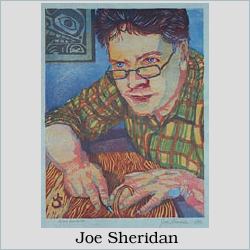 |
Joe, please tell us about yourself and your woodblock art.
I am a "part time" woodblock artist.
What do you do
in your non-part time occupation?
Professionally I work as a stage manager in the theatre. I am
currently working on the Broadway production of "Kiss Me Kate". For many
years I toured with a number of Broadway shows including "Show Boat", "A
Chorus Line", "Evita", "Fiddler on the Roof". If you live in the United
States or Canada the odds are good that I played a city near you. I have
also worked in Tokyo, Kobe, Osaka and Nagoya Japan. My first aspiration in
the theatre was to become a scenic designer. I found that I enjoyed stage
managing and also that I could make a living doing it! Throughout my theater
work my artistic endeavors continued in the form of
watercolor.
What got you interested in Hanga?
Several years ago (almost 20 years ago) I saw my first Japanese
woodblock prints. They were part of an exhibition of works by Impressionist
artists and their influences. I was hooked by the first Hokusai and
Hiroshige that I saw. While I could never hope to own something by Lautrec
or Van Gogh, I soon found that I could own a Japanese print. I started
collecting 19th Century Japanese woodblock prints. Later I discovered the
20th Century Shin Hanga artists, namely Yoshida Hiroshi, and Kawase Hasui.
The technique of these artists fascinated me. These artists somehow
controlled this water based technique to (dare I say?) perfection. I had to
find out how they accomplished this. I studied prints and read whatever
books I could obtain on Japanese woodblocks. As my research grew I
discovered the prints by non Japanese artists, Paul Jacoulet, Charles
Bartlett, Helen Hyde, Frances Gearhart, and Walter J. Phillips all of whom
were influenced by the Japanese technique. I felt I had to try my hand at
this technique.
Did you start cutting and printing right away,
then?
Throughout my touring years I could not dedicate the time
necessary to learn and experiment in the Japanese woodblock technique. Years
later I finally had time to attempt my own print in this technique. That was
four years ago. I have done four woodblock prints since
then.
How did you find the necessary equipment to get
started?
I found McClains printmaking supplies in an artist supply list
in "The Complete Printmaker" by Ross/Romano/Ross. I ordered a baren, paste,
chisels and paper. I had started. The first block I carved on was a piece of
Birch ply. This proved to be unsatisfactory and I then tried a poplar plank.
Between my inexperience and the lack of the correct materials I was not very
successful. I ordered better paper, chisels and shina ply from McClain's and
continued to learn. In my internet search for woodblock information I
discovered Matt Brown's site, http://www.ooloopress.com. He had a
link to Baren! Well, there was an immediate bookmark! I was ecstatic to find
the Baren group. I downloaded information (one point lessons, the Phillips
book, the Yoshida book) by the disk load! My first three woodblocks were
landscapes inspired by a visit to Banff Park in the Canadian Rockies. Of
these I only editioned my first print. I consider the next two still in a
color proofing stage.
Tell us about your Exchange #4 print, the
self-portrait.
My self portrait is my fourth woodblock The print itself
contains nods to some of my favorite traditions and artists. First, Petrus
Christus' painting, "A Goldsmith in His Shop", circa 1449 inspired the
format. The image in the background is my tribute to the great linear
tradition of the Native Americans of the Northwest. Robert Davidson and Joe
David are my favorite contemporary artists working in that ancient
tradition. The Japanese nature of the print was inspired by Natori Shunsen,
(1888- 1960). Shunsen was an artist who specialized in marvelous Kabuki
portraits. His work was executed by the Watanabe Publishing
Company.
Nitty Gritty details, please!
My portrait was worked up and then reduced to a line image. Then
the line image was put on a copy machine. Using lacquer thinner I
transferred the copied line image to my blocks. My print started on shina
ply but I found that the image demanded a better line. I then carved cherry
blocks to supplement the ply blocks. A total of 12 blocks were used. The
printing process went into 18 stages. I experimented along the way. I made
mistakes. I had to re-carve parts of blocks. This re-carving raised the
number of stages in the printing process. I proofed on Arches paper. I
proofed again on Torinoko and finally I printed on Nishinouchi
paper.
What kinds of carving tools do you prefer?
I use Japanese chisels. I have ordered chisels from McClains as
well from the Japan Woodworker. (I have found the Michi line of chisels
suitable only for shina work. They do not work cherry
well.)
And your pigments?
I use Kremer pigments suspended in water and or gum arabic.. I
worked with a limited palette, mixing most of my color in this portrait from
cobalt blue, bright yellow and bright red. As always it was a learning
experience.
We have images of two more of your prints, tell us
a little about them.
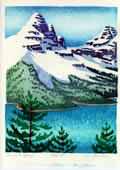 |
Banff '96 Spring
=A9 Joe Sheridan, 1997 |
My first print, entitled "Banff '96 Spring" is of a lake in the Banff National Park. There were 26 prints completed in 1997. The second is entitled "Emerald Lake", which is a resort area in the same park system of the Canadian Rockies. This print needs to be fine tuned and then I will edition it.
I look forward to comments on these prints and would be happy to answer any questions. I am not sure what my next image will be, however it will probably be a landscape of some sort. |
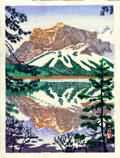 |
Emerald Lake
=A9 Joe Sheridan,
1997 |
Any tips on the landscape cutting?
I find that one of the most challenging aspects of printing is
the determination of the printing order of each block. This process also
must also take into account the color overlays. I "try" to have this process
worked out prior to the first cut.
Thank you Joe, it was really
nice talking to you via e-mail! I know the "Baren-Suji" readers will enjoy
learning about you and your print processes.
Joe Sheridan lives and pursues woodblock printmaking in Sea
Cliff, New York, U.S.A. He can be reached by e-mail at: sheridanpsm@email.msn.com
Wanda Robertson lives and works near Portland, Oregon U.S.A. and can be
reached at: robertson@canby.com
 WOODCUTS FROM ALL OVER
WOODCUTS FROM ALL OVER
Contribution by Dimitris
Grammatikopulos
JULIAN JORDANOV, Wood Engravings
By 1995, I (Dimitris Grammatikopulos) was already transferred to Bulgaria.
I was studying at the school of Fine arts of the Veliko-Turnovo University
"St.St. Kyrillus and Methodius". In September, 1996 a friend introduced me to the more peaceful person
I've ever met. Julian Jordanov, rarely goes out anywhere and mostly works in
his attic, next to the small square window overlooking the town of Lovech,
former capital of Czar Asan of Bulgaria.
What he does enjoy doing outdoors
are forest walks and gathering all kind of dry seeds, weeds and such, which he
uses to create an evergrowing army, supposed to keep him safe from all evil. I
think it works.
Visiting my site www.plaindotline.gr, you'll get the chance to
see a very small sample of his work. Mostly ex-librises and a couple of more
free subjects.
I will try and get for you his "Icarus" and "Down the wind
of the ancient seas" as well as the "Rain cries in deserted gardens". Is it my
imagination or are the titles already saying a lot?
Julian and I we've had
a common exhibition in October, 1996 and for me one of the best things I've
ever been told was his opinion that, I choose better subjects than him. I
never believed him! He has poetry in his lines, and his passion for work. He
gives people an urge for achievement.
That's one thing I'll sign for!
Today he's planning the next international competition to apply to and get
the applause he needs not.
We await your contributions for this section. A
thumbnail will do, and if you have a website, we will link the thumbnail to
a larger version on your pages. Thank you.
 MEMBERS IN THE SPOTLIGHT
MEMBERS IN THE SPOTLIGHT
Jeanne Norman Chase
Jeanne was recently featured in her hometown newspaper, the
Pelican Press. Here are some clips of the article:
The Artistry
Behind New Starts by Thyrza Jacocks
(Excerpts)
For the working
professional, change is ever more than a constant: it is the crucial
ingredient. Because artists do things for themselves, express themselves in
work that may be original and lasting, change underscores all, and new starts
can be epiphanies. In this new year, new millennium, Jeanne Norman Chase has
overturned her art past. After 17 years teaching painting at Ringling School
of Art and an active gallery life in the U.S. as a recognized realist painter,
she has put aside paint and brushes to become a printmaker.
On the
Internet about a year ago she found the Baren Group of international artists
who are creating woodblock prints and discussing the techniques of this
ancient art form. This electronic group was begun by a Canadian Master living
in Tokyo, and to date has published two very handsome folios. Each artist
submits one woodblock print, the folio cases are made in Japan, then they and
the prints are sent to one member who agrees to collate them and mail them to
the other members. The presentation is beautiful. The prints range from the
highest professional level of intricacy, innovation and skill to that of the
student artist who cuts and prints a single block.
While Chase is
connecting her 20th century Internet with a 14th century art form, she is also
working at other types of printmaking. A year ago she attended a print
workshop in St. Ives, Cornwall England and one on non-toxic printing materials
in Grand Prairie, Canada. Her next important change to complete this new start
is changing her web site from Paintings by Jeanne Norman Chase to The Graphic
Work of Jeanne Norman Chase.
"Patterned Behavior"
Moku-Hanga: Japanese Waterbase Woodcuts
by April Vollmer and Sarah Hauser
Gallery 402 at OIA
April 18 to May 19, 2000 |

=A9 April Vollmer and Sarah Houser, 2000 |
This show will explore juxtapositions between artificial
repetitive patterns and patterns in nature. Both artists utilize the
centuries-old technique of Japanese Ukiyo-e woodblock printmakers. They bring
to these traditional Japanese materials and methods their own individual
styles and content. This labor-intensive printmaking process invites the use
of multiple carved blocks, achieving a rich and luminous effect in the
layering of line, color, pattern and texture.
April Vollmer received an M.F.A. at Hunter College. In addition to a
recent solo exhibit at A.I.R. Gallery, the artist has exhibited at the Islip
Art Museum, Goddard Riverside Art Center, Dieu Donn=E9 Papermill and other
galleries nationally and internationally. She has curated exhibitions
concerning environmental issues at Henry Street Settlement, Abrons Art Center,
Minor Injury Gallery, the Bronx River Art Center and other nonprofit spaces in
New York City. She has also organized an exhibition at Ceres Gallery of women
artists who use printmaking as a primary means of expression. April is a
member of the Lower East Side Printshop, and has taught hanga workshops there
and at other locations across the country.
Sarah Hauser was bom in San Francisco, and has lived in New York for
the past twenty years. She studied drawing at the Art Students League and
Spring Studio; and studied painting, printmaking and papermaking at Cooper
Union, Manhattan Graphics, the Lower East Side Printshop and Dieu Donne
Papermill. Her exhibitions in the U.S. and abroad have included Barrett House,
Noho Gallery, Woman-Made Gallery (Chicago), Dean Lesher Regional Center for
the Arts (California) and Third KIWA Exhibition and Tour in Japan. She has
steadily built a body of work, evolving from drawing and painting to
monoprints, linocuts and woodblock prints. During the past few years she has
become completely immersed in the Japanese method of woodblock printmaking,
which she studied with Jonathan and Miwako Glick, Kathy Caraccio, April
Vollmer and Yasuyuki Shibata. Sarah is also currently teaching papermaking and
other art projects to public school children through Dieu Donne Papermill and
Arts Connection.
The gallery is located on the fourth floor of 402 Hudson Street. Gallery
hours are Tuesday - Friday, 1-5 p.m. The opening reception will be Thursday,
April 20, 5-7 p.m.
For further information, contact Nadini Richardson or Pam Cooper at
212-219-9213. April Vollmer can be contacted at 212-677-5691 or by e-mail atjy6@columbia.edu. Her work can be
viewed on the internet at her website at http://www.aprilvollmer.com. Sarah
Hauser can be contacted at 212-967-7711 (X3083) or by e-mail at Cucamongie@aol.com. Her work can be
viewed on the internet at http://www.barenforum.org/members/hauser/
(index of images appears here, you can click on any one of them).
Photos are available on request.
April Vollmer and Sarah Hauser will also be demonstrating hanga technique
at the Brooklyn Botanical Garden's Cherry Blossom Festival Saturday and
Sunday, April 29 and 30, from 1-5 p.m.
 Woodblock Prints in Bulgarian
Printmaking
Woodblock Prints in Bulgarian
Printmaking
by Arafat Al-Naim
Editor's Note: A large selection of Bulgarian Woodcuts is
currently showing in
The Printmaking
Studio
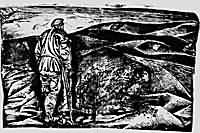 |
Galilei Simeonov
Our Fields, 1969
55 x 88 cm |
 |
Lyuben Stoyev
Mother with Child-Tansaniz
68 x 35 cm |
 |
Vido Vulov
Harvest, 1970 |
The task of
this article is not historical, nor is it analytical; it is an overview to
show the most typical and finest work of the best known and most active
Bulgarian woodblock artists.
Bulgarian graphic art has its own entirely definite, rich and complex
aspect. The creative spirit of the Bulgarians is not alien to the fundamental
structure of graphic art, to its poetic essence or its vibrating power. In the
medieval icon and in Bulgarian mural paintings, but chiefly in the Old
Bulgarian miniatures, there are elements, which, as far as plastic idiom and
style are concerned, belong to graphic art rather than to painting.
The real beginning of Bulgarian woodblock prints lies in the middle of 19th
century, during the national revival period when the foundations of Bulgarian
culture were laid. Two formal trends appear in the graphic works of the
Revival periods, which are patriotic and educational in content: first is a
striving to imitate 'academic' European drawing, and second is the
continuation of the old Bulgarian "style of painting". The second is the
better and more skillfully manifested in woodcuts.
The woodblock prints flourished in Bulgarian monasteries. Cheap and
appreciated woodblock prints were bought by visitors to religious centers. As
early as 1822 in the Vratza monastery there was a woodblock printing workshop.
A similar workshop was founded in the famous Rila monastery. On the road to
Rila monastery lays the town of Samokov renowned for its woodblock printing
school. Two families, the Karstoyanovs and the Klinkovs, dominated the
woodblock prints in Bulgaria until the liberation.
The graphic charm and purity of style of prints were appreciated with
certain delay by the following generations, and ties with it were gradually
broken, as with the icons and mural paintings of olden times and the National
Revival Period. The other trend continued in graphic art after the liberation
from Ottoman domination.
The creation of a new Bulgarian culture in the newly liberated,
poverty stricken country was a difficult process and in this period there was
no graphic art to speak of, nor could one think of any continuity of the kind
that existed in European art at the time, despite the noble efforts made only
by the artists of the day- Nikolai Pavlovich, for instance - to "Modernize"
and "Europeanize" Bulgarian art, and not to allow graphic art to lag behind.
In a modern sense, graphic art only come into being in Bulgaria in
the "twenties" or rather the early thirties of 20th century. This reappearance
is more definitely connected with the name of Vassil Zhariev (1895-1971), who
not only restored continuity with the prints of the Revival period, a
continuity that had been broken in many respects, but succeeded in modernizing
this continuity and in laying the foundations of a fully contemporary art,
such as we perceive it and accept it today.
The new Bulgarian woodblock prints, which underwent various stages of
development up to present, began with the works of Vassil Zahariev, Vesselin
Staikov (1906-1970), Dimiter Draganov (b.1908), Georgi Gerassimov (b.1906),
Sidonia Atanasova (b.1909), Yuli Minchev (b.1923), Zlatka Dubova (b.1927),
Preslav Kurshovski (1905), Petrana Klissourova (b.1908), Binka Vazova
(b.1909), Vladimir Korenev (b.1912) Metodi Mitev (b.1918), Evtim Tomov
(b.1910), Zaphyr Yonchiev (b.1924), Georgi Penchev (b.1924), Pencho Koulekov
(b.1924), Elka Zaharieva (b 1928), Galilei Simeonov (b1929), Mircho Yakobov
(b. 1930), Vido Vulov (b.1930), Mihail Petkov (b.1933), Ivan Kozhouharov (b.
1934), Violeta grivishka (b.1937),Lyuben Stoyev (b. 1939), Ralitsa Nikolova
(b.19 ), Vassil Popov (b.19 ), Zdravko Zahariev (b.1937), Anton
Petkov (b.1928) and other graphic artists feature the contemporary woodblock
prints in Bulgaria, possessing its own characteristic features, and at the
same time its typical representative, striking talents and lasting works.
The characteristic features of contemporary Bulgarian woodblock prints are
free development of creative personalities, individual styles and idioms, new
plastic quests, variety in technical interpretation, and the turning to new
problems and contemporary themes.
EDITOR'S NOTE: Due to space limitations in the newsletter, only three
works are shown here. However, an astounding collection of woodblock prints by
the artists mentioned can be seen here:
http://www.printmakingstudio.com/bulgaria/bulgariawoodcuts.html
Browse through these beautiful works with time on your hands and look
at the large versions of the prints to get the full effect of the
craftsmanship of these artists, you will be glad you did.
Bibliography
Tomov, Evtim.
RELIEF PRINTMAKING. Nauka u Izkustvo. Sofia 1973.
Boshkov, Prof. Atanas. VESSELIN STAIKOV, catalogue. Bulgarian
Artist publishing house. Sofia, 1986.
Pencho
Koulekov. Catalogue, Sofia 1984.
Dora Kamenova.
VASSIL ZAHARIEV. Alexsandrov publishing house. Sofia 1995.
Kirov, Maximelyan. CONTEMPORARY PRINTMAKING IN BULGARIA. Article, Art
magazin N0: 6-7/ 1969.
Peter Velichkov. 100 BULGARIAN
EXLIBRIS. Bulgarian Artist publishing house. Sofia, 1985.
Chouhovski Peter. MODERN BULGARIAN GRAPHIC ART. Bulgarian Artist
publishing house. Sofia, 1971.
 Worthwhile Books In
Printmaking
Worthwhile Books In
Printmaking
by Barbara Mason
The making of a Japanese print: Harunobu's "Heron
Maid"
Cost: $15
With an introduction by Reiko Chiba
Published by Charles E Tuttle Co, Tokyo, Japan third edition 1964, 13
"double" pages
This is a rather small book, about 3.5 x 5 inches and the pages are double
folded in the Japanese style so they may be printed flat and folded accordion
style into a book. The cover is reminiscent of a cloth Japanese screen with
the key block in gold on a white ground with red, blue and navy.
There is a brief overview of Japanese printmaking and of Harunobu's work.
Little is known of his life; he died on June 15, 1770 at the early age of 45
leaving many fine prints as his life's work. "The beauties he depicted
still charm connoisseurs of later generations"
At first glance this step by step demonstration showing each stage of a
woodblock print is unassuming, but on further examination, it is delightful.
There are 8 color blocks plus a key block and an embossing block. The bokashi
shading on the next to the last block could make you cry it is so beautiful.
This would be a good addition to anyone's library. As they say, good things
come in small packages.
Wood-Bock Printing by Tomikichiro Tokuriki, translated by
Teruko Arimatsu
Published by Hoikusha Publishing Co. Ltd Osaka,
Japan 6th edition 1975, 127 pages
Cost: $25
This is a small book
about 4"x6" with a paper cover. Tomikichiro Tokuriki was born in 1902, the
13th generation of a family of artists. He studied and graduated from the
municipal School of Arts and Crafts and the Kyoto Technical School of
Painting. He studied engraving and picture printing from Keikichi Hino and
Tokuzo O'iwa respectively. He established his own publishing firm for his
wood-block prints after World War II.
A fairly good how-to book, but it assumes the person printing actually
knows more than a beginner would know. Although a great help, it would
be hard to start from scratch with this book if no other help was available.
All the tools are depicted and there are good photos of every step, even
recovering the baren. There are many color and black and white photos of
actual contemporary prints, 96 done by the author and approximately 70 by
other artists. A concise history of Japanese printmaking ends the book.
This would be a good addition to any library on printmaking, I enjoyed
it!
 The 2000 L.A. Affair
The 2000 L.A. Affair
by Bea
Gold
 |
The first Baren, L.A. Meeting took place February 19 and 20, 2000 at the homes of Bea Gold on Saturday and at Ruth Leaf on Sunday. Our group was made up of Baren Members, from right to left:
Maria Arango (our special Las Vegas infiltrator), Dutch Stowe-North Hollywood, Bobbie Mandel-Huntington Beach, Georgia Garside-West Covina, Ruth Leaf-Venice, not pictured here was Pete White-Colton (the handsome young man in the lunch picture below) and Bea Gold-Los Angeles. |
| The meeting started on Saturday at 1:00p.m. We started with (a delicious, editor's note!) lunch and each person then introduced themselves and talked about their personal history, particularly as it related to art in general and woodblock printing in particular. Of course, we discovered that no matter the age or background each of us was passionate about our love for carving and printing wood. We spent some time looking at the books that people brought, talked about the LA Print Society and got to know one another. |
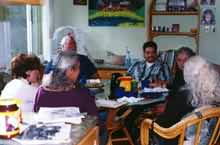 |
| After lunch we adjoined into Bea's studio and she shared her workbench set-up and what she found different in doing hanga prints. She started by having people smell the stinky brushes she had burned and talking about the reason for the burning. A handout was presented to the group and she talked about and demonstrated each of the items on the list. |
 |
|
|
Bea in the midst of a brushing demonstration. A print in progress waits patiently on her bench. |
|
|
| Bobbie had to leave at 5:pm and plans were made for the next day. We would meet at Ruth's at 10:00 a.m. We then looked at Exchanges # 2, 3,and 4. Time was spent admiring and critiquing the 90 prints. Roxanne Sexauer, Long Beach, was planning to bring Exchange # 1 but was unable to be with us. She was working to complete a printing for the SGC (Southern Graphics Council) meeting coming up in a couple of weeks. We had (a scrumptious! editors note) dinner and spent time just relaxing and talking about our interest in the internet and how the Baren had brought us together. The meeting broke up at about 9:00p.m. |
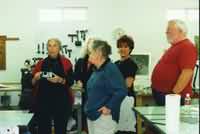
At Ruth's studio... |
Sunday, we met at Ruth's. Pete was unable to be with us
because of work commitments. We started with coffee and a
discussion about collaboration on a print. We then went into Ruth's studio,
which is beautiful and very impressive. We looked at prints and
discussed presses, etchings, wood, woodcuts and methods for drying
prints. Georgia brought some work to share, which we admired and talked
about a next meeting possibly in San Diego. Maria started to
metamorphose into a pumpkin at noon so we adjourned until next time. A
good time was had by all, and our Exchange #4 self portrait prints made all
those prints come to life!
 A PRINT CONSERVATION PRIMER
A PRINT CONSERVATION PRIMER
by Jack Reisland
So you've just discovered a great Hasui print at a
local estate sale, or you've just received a bunch of nice new prints in a
print exchange, and you would like to know how to keep them looking as nice as
the day you got them? Is it okay to hang them on the wall, or should you hide
them under the socks in your dresser drawer? Just what is the best thing to do
with them? In this article we will look at this question, and try to come up
with the best solutions for the long life of your treasured prints.
Causes of Deterioration of Prints
To discuss the best way to care for your prints, it will help to
first look at those things that can shorten the life of your works of art. The
factors that must be taken into account when considering the lifespan of a
print are acids, both residual in the work of art itself from the paper making
process and acids introduced from contact with other acidic materials,
humidity, temperature, air pollution, light, insects, and care in handling. We
will look at each of these factors in turn, and the ways that they can
interact to determine the survival of your print.
Acids
The acidity of objects is
expressed in pH, on a scale from 0 to 14. 7.0 is considered to be neutral,
below 7 is acid, and above 7 is alkaline. Paper is generally made of some form
of plant fiber, or cellulose. Cellulose itself is almost neutral in pH, at
6.6, and by itself is fairly stable.
Acid can enter paper in several
ways. First, it may be present in the materials used to make the paper in the
first place. Wood pulp contains along with cellulose, lignin, which is
chemically unstable. As it breaks down it produces acid, which attacks the
cellulose fibers in the paper. Unrefined woodpulp paper, such as newsprint,
has a lifespan of only a few years. However, sulfite pulp paper (paper made of
wood pulp that has been chemically treated to remove the lignin) can be a
fairly durable paper. In the West, the most durable papers have been made by
hand from cotton and linen fibers from disintegrated rags. The strongest and
most durable papers are those that are hand made in Asia of long plant fibers
such as Mulberry and Gampi.
Acid can also be introduced into the
paper making process in the form of bleach. Traditional bleaches developed at
the turn of the century and used in paper making contained chlorine, which is
highly reactive and can form hydrochloric acid. Alum used in the sizing of
paper can produce sulfuric acid within the paper.
Acid can also be
introduced into the paper at any time after it is produced, through contact
with an acidic material, or an acidic atmosphere. The most common way that
acid is introduced into an existing print is through contact with acidic
papers or cardboards in poor quality framing.
Acid in the paper of
prints causes discoloration and embrittlement of the paper, can increase the
rate of discoloration through oxidization of metallic and metallic oxide
pigments, and can affect the rate of fading of other pigments.
Humidity
When paper is exposed to high
levels of humidity, over 68 to 70 percent, it quickly becomes susceptible to
the growth of micro-organisms that can rot the sizing and cause staining of
the paper. Cellulose and gelatin size are both excellent sources of nutrients
for fungi. Once the sizing has been attacked, the paper becomes more
absorbent, and the cellulose of the paper is more quickly colonized by fungi.
The growth of specific fungi in the paper is now believed to cause the
staining in the paper in small spots, commonly called "foxing". If the
growth of fungi in the paper continues unchecked, the paper can become
brittle, and larger staining from various fungi may appear. Excess humidity
can also cause the wrinkling and buckling of the print, which can be
particularly evident when the print has been improperly mounted.
Temperature
The main concern in the
variation of temperature on the lifespan of prints is its relation to
humidity. Relative humidity is a function of the amount of moisture present in
the atmosphere, and the temperature of the environment. If there is a drop in
temperature, the relative humidity goes up, even with no increase in the
amount of moisture in the atmosphere. This is especially significant in a
small closed atmosphere, such as a plastic envelope or a sealed frame, where a
rapid fluctuation in temperature can cause actual condensation of water vapor
on the inside surface of the plastic or glass, and the swift growth of
damaging micro-organisms on the print inside.
Air Pollution
As mentioned before,
acids can enter into paper in the form of acidic air pollution, particularly
when combined with high levels of humidity. Pollutants such as sulfur dioxide
are converted within the paper to sulfuric acid. Dust, which can cause
staining, and mold spores, which can infect the paper, are also carried in the
air.
Light
Light can damage both the paper
and the pigment of a print, causing the paper to become discolored and
brittle, and the pigments to fade. Light acts in two ways to cause this
damage. The first way is by directly breaking down the molecule of both the
cellulose in the paper and the pigment forming the print. This is known as
photolysis. The power of light to break down molecules is inversely
proportional to its wavelength. That means that the shortest wavelengths are
the most powerful, and ultraviolet light the most powerful of all. The second
way that light can damage a print is in combination with the environment of
the material, including water vapor and oxygen. Water vapor and oxygen, in
combination with light, form substances that age both the paper and pigments.
This is known as photo-oxidation. The light energy necessary for this
kind of degradation is much lower than for photolysis, so while the removal of
ultraviolet radiation by filters is always advised, it must be pointed out
that this will not stop many kinds of photo-oxidation. Therefore the reduction
of the total intensity of the light on the surface of the print is important
to reduce the degradation of the print.
The interaction of paper
degradation and pigment fading is a function of the qualities of the paper
used, and the kind of pigments on the print, and to a lesser degree some
variables such as the sizing and any binders used. Pigments will fade faster
on a poor quality paper, and obviously, some pigments fade much faster than
others. Also, some pigments turn different colors as they are subjected to
light. Many ink colors are a mixture of different pigments, and those pigments
fade at different rates, thereby skewing the tone of the ink as it fades.
Insects
Insect damage is fairly
obvious. The presence of gelatin and starch used in the manufacture of many
papers increase the potential for insect infestations, as does higher levels
of humidity. They eat the paper, usually causing small holes scattered through
the paper. Insect droppings can also cause staining of the paper.
Care in Handling
Negligent handling of
prints probably causes more damage to prints than any other single factor.
Poor treatment of prints can cause creasing or tearing of the paper.
Staining can be caused by unclean hands or surfaces. Pigment and paper surface
loss can be caused by abrasion. Some of the worst damage is caused by ill
informed mounting and framing practices. Prints are often folded or trimmed to
fit in undersized frames, matted and backed with highly acidic cardboards, and
repaired and mounted with irreversible and staining tapes and adhesives.
In the next article, we will see how to take all of these factors
into account in planning for the optimal handling, display and storage of your
valued prints. A number of references for consultation on print conservation
will also be included.
Jack Reisland is a Baren member and a Conservator in private
practice in Hawaii.
 TECHNICALITIES
TECHNICALITIES
by David Bull
An excerpt
from 'Your First Woodblock Print', an upcoming new section of
the
[Baren] Encyclopedia of Woodblock Printmaking.
Stages in Cutting a Block
Here's a side view of a finished block - the 'area for
printing' is the original surface of the wood. Such areas are
surrounded by 'valleys' - places where the wood has been carved away. When
pigment is rubbed on such a finished block, and paper pressed onto it, only
that untouched surface area will make the impression ...

Carving a block like this is a three step process:
- cutting around the lines and areas of the design
- clearing away the bulk of the unwanted wood
- final trimming up to the cut lines
Cutting the lines with the knife:
You can hold the carving knife either in your fist (giving stronger
cutting), or just like a pencil (giving easier guidance). Cut around the lines
of the design, holding the knife at an angle that will produce a beveled edge
on the final areas (see the image). Keep the tip of the blade about 1 ~ 2mm
deep in the wood, and go right around the entire outline of each area.

Although in the old days here in Japan it was considered a matter of pride
for the carver not to rotate the block as he worked, we mortals feel no
such restriction. Move the block into a convenient orientation for each
particular cut.
The general motion is to cut along one side of the line as you draw the
knife toward you ...
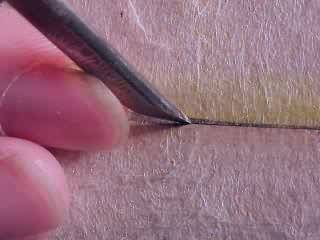
... then turn the block around and cut the other side of the line in the
same way.
At each point where lines intersect, or where there is a 'corner' in the
design, make an additional cut (in the white area) and pop out a small
triangle at that point.
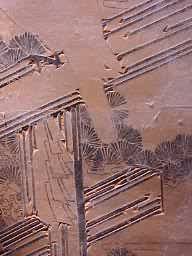
This will make it much easier to see where you have cut, and will also make
subsequent clearing work easier ...
When all the lines have been cut, it's time to move on to the clearing
stage ...
Clearing the waste wood:
With all the lines of the design cut, the next step is to clear away the
'waste' wood from wide areas of the image. This illustration shows the basic
idea - leaving the printing areas of the block completely untouched at this
point, scoop unneeded wood away with a gouge or chisel. Note the shape of the
'excavation' - a valley that gets deeper in the middle.

There is a very important reason for this valley - once we start printing,
pigment will be smeared over the entire surface of the block, and if
the paper happens to sag a bit in places, and come into contact with unwanted
areas, blotches on the print will result. The general idea is simple - the
further you get from the carved lines, the deeper you go. How deep? Well,
experience will certainly show you, once you start printing, but a general
rule might be to gouge out nearly a centimetre down at a distance of about
three centimeters out ...
If you have any very wide unneeded areas of the image it is not necessary
to dig away the entire area. Halt your excavations at a distance of around 4
or 5 centimetres away from the nearest image line - following the pattern seen
in the illustration above.
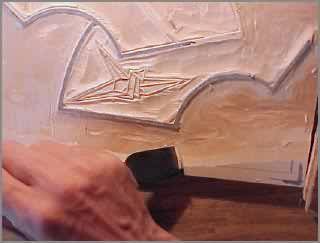
Important note: Do not try and scoop right up to the cut lines.
Follow the example in the illustration at the top of this page, and keep your
distance - around 2~3 millimeters at least. If you try to bring your chisels
or gouges right up to the lines, you will surely chip some of them away, and
your print will be full of unsightly gaps in the lines.
While carving the key block, it isn't necessary to fix the block to your
working table, as no strong force is exerted on the wood at that stage, but
when clearing waste wood, the block has to be restrained somehow. A simple
'bench hook', which you can easily make yourself from scraps of waste wood, is
far and away the easiest solution to this problem.

It is 'hooked' onto the front edge of the workbench, and the block placed
on top, against the bar at the back. The gouges and chisels can then be pushed
through the wood, with both hands held safely behind the cutting blade.
Final trimming with the flat chisels:
The last stage in the cutting of a block is to trim away that final bit of
wood up against the cut lines. The tool of choice for this is a small flat
chisel:

It is at this stage that many inexperienced printmakers meet their first
major problem. While moving the chisel along the line to trim away the excess,
the line itself can easily become chipped. If the carving knife had not cut
quite deeply enough at any point back in the first stage of cutting on the
block, then the line at that point can easily be chipped by the chisel now.
Try and move carefully, 'feeling' your way along the line as you go. The wood
should generally slice away with no problems, but if you feel stronger
resistance at any point, don't just push harder - you will surely chip
the line. Stop, pick up your carving knife again, and re-do the original cut
at that point, making sure that you cut deeply enough to allow the waste wood
to be separated from the 'good' part of the block. Then, when you are sure
that they are truly separated, switch back to your chisel and continue slicing
away the waste. Being careful at this point will make a tremendous difference
in the appearance of the finished print ...
To be continued later ... in the [Baren] Encyclopedia ...
 OPPORTUNITIES FOR PRINTMAKERS
OPPORTUNITIES FOR PRINTMAKERS
compiled by Maria
Arango
WORKSHOPS:
April Vollmer
174 Eldridge St, NYC 10002, 212-677-5691
http://www.aprilvollmer.com
e-mail atjy6@columbia.edu |
Kala Art Institute Hanga Woodcut for Contemporary Artists
Saturday and Sunday April 8 and 9, 10:00 to 5:00
1060 Heinz Avenue, Berkeley California 94710
510-549-2977
http://www.kala.org/ |
|
Lower East Side Printshop
Six weeks, June-July 2000, dates to be announced
59-61 East 4th Street, New York, NY 10003
212-673-5390
http://www.printshop.org/ |
|
Horizons Craft Program
Hanga Woodcut, Elderhostel week, (ages 55+)
August 14-20, 2000
Sunderland, MA
413-665-0300
http://horizons-art.org/ |
|
South Dakota July 10 to 16
Karla's e-mail,
khackenm@bmtc.net
|
Japanese Block Printing - Richard Flavin
'Paper & Book Intensive', a working sabbatical for practitioners and serious students in the book arts, papermaking, and conservation. |
To be held in Saugatuck, Michigan, from June 7-17, 2000 This course will teach participants the steps in creating a color wood-block print, from transferring an image onto a block, cutting the block and finally printing with watercolors using the traditional hand-held baren. Each member of the course will complete an edition in enough copies so that a portfolio can be exchanged.
Their website is at:
http://www.slis.ua.edu/ba/pbi2000.html |
EXHIBITIONS AND CALLS FOR ENTRIES:
NOTE: Date given is deadline for entries. Be sure to request
the prospectus. Editor highly recommends subscribing to Art Calendar and Art
Deadlines if you find these useful and will be entering competitions.
April 30, 2000 WATERMARK 2000, NATIONAL JURIED EXHIBITION, WORKS ON
PAPER, 1 to 5 Slides for $25. Deadline for slides: May 10, 2000.
Awards: 1st - $400, 2nd - $200, 3rd - $100. Juror: Ralph Steeds.
Professor of Art, UNCP. For a prospectus send an SASE to: Studio 107,
Box 2265, Whiteville NC 28472 OR Phone: 910-642-7141x237 OR FAX:
910-646-1015 OR Email: dmccormick@mail.southeast.cc.nc.us
Apr 18, 2000 MARKS ON PAPER 6/18-7/29. Open to all artists 18+
working in prints, drawings, pastels. $1,000+ in awards. 35%
commission. Entry fee. Group provides shipping option at extra cost if
work is not hand-delivered. Must have entry form. For a prospectus
send an SASE to: St Louis Artists' Guild, Two Oak Knoll Park, St Louis
MO 53105 OR 314-727-6266 OR http://www.stlouisartistsguild.org
Apr 30, 2000 INTERNATIONAL MINIATURE PRINT COMPETITION July/August
2000. Contact: Debra Yelva, New Leaf Editions & Dundarave Print
Workshop, Granville Island Vancouver BC, Canada OR
http://www.info-hwy.com/newleafeditions
OR newleafeditions@canada.com
May 01, 2000 NATIONAL SMALL WORKS EXHIBITION Open to all
artists, all media not to exceed 18 inches in any direction. Cash
awards, purchase prizes. 50% commission, insurance. Entry fee. Must
have entry form. For a prospectus send an SASE to: Pedestrian, Gallery
of Contemporary Art, 2141 Park St, Jacksonville FL 32204 OR
http://www.pedestriangallery.com
Jun 30, 2000 BIENNALE INTERNATIONALE D'ESTAMPE CONTEMPORAINE DE
TROIS-RIVIERES The Biennale is a major event aiming to achieve
diffusion and visibility of contemporary printmaking of all horizons.
The selected artists will have from 3 to 7 artworks shown in the
exhibition, providing the visitors with the occasion of discovering or
acknowledging their artistic proposals. Catalog. Cash awards. For more
information and application form, please contact: Biennale
Internationale D'Estampe Contemporaine de Trois-Rivieres, 1425 Place
de l'Hotel-de-Ville, CP 368, Trois Rivieres Quebec G9A 5H3, Canada OR
819-372-4611 OR http://sites.rapidus.net/biennale.trois-rivieres
LOS ANGELES PRINTMAKING SOCIETY ANNOUNCES ITS 19TH ANNUAL EXHIBITION
When: January 14 to February 20, 2001
Juror: David Rodes, UCLA
Grunwald Center, Armand Hammer Museum, Los Angeles
Where: Laband Art
Gallery, Loyala Marymount University, Los Angeles, CA
Fee: $25 for 3
works, $30 for five works (LAPS members $20 and $25 respectively). All funds
must be paid in U.S. dollars.
Slide Deadline: July 22, 2000
Awards: The 15th National yielded approximately $15,000 in awards
and acquisitions from individuals, corporate collections, and public art
collections. A number of works went into the permanent holding of the
Department of Prints & Drawings, Los Angeles County Museum of Art; Orange
County Museum of Art, Newport Beach; UCLA Grunwald Center, Armand Hammer
Museum, Los Angeles; Montgomery Gallery, Pomona College, Claremont; University
Art Museum, California State University, Long Beach. A record 32 works were
acquired from the 15th National Juried Exhibition.
Exhibit Calendar:
July 22, 2000: Postmarked deadline for submission of
slides, entry fee, entry card, and jury notification card.
August 22,
2000: Notification of juried results mailed.
October 1, 2000: Accepted
artists deadline for receipt of publication quality slide and artist biography
profile.
November 20 to December 8, 2000: Receipt of shipped artwork at
Laband Art Gallery
December 8 and 9: Receipt of hand delivered artwork at
Laband Art Gallery.
January 15, 2001: Opening Reception at the Laband Art
Gallery.
February 20, 2001: Exhibition closes.
February 22 to 26,
2001: Outgoing shipping of artwork.
February 22 & 23, 2001: Pickup of
hand delivered artwork.
For a prospectus send a self-addressed stamped envelope to:
LAPS 16th
National
Janice Ledgerwood
Exhibition Chair
14031 Visions Drive
La Mirada, CA 90638
USA
Or download a prospectus from the website
for the Los Angeles Printmaking Society: www.art2u.com/LAPS/
2nd International Exhibition of Small Graphic Art in Venice
The
information is here
http://www.artaddiction.se/news3.htm
"MASKS in VENICE 3" PICCOLA GALERIA CORRER VENEZIA
CORRER POCKET
GALLERY VENICE for those who are
interested here is the full information
http://www.artaddiction.se/news4.htm
OTHER OPPORTUNITIES:
Artists be seen on the web! There are several ways to get online and have
your work seen by thousands of viewers on the internet. Some are costly, many
are free. Following is a link to a compiled list of sites that offer free web
space, some even free page design, good surfing! FREE WEB
SPACE
If anyone would like to take over the compiling of this
department, it is up for grabs! I usually just gather the upcoming printmaking
competitions and some promising works on paper calls for entries, and make a
text file. Let me know if you are interested.
Sources this issue: Art
Calendar, Art Deadlines,
American Artist, direct e-mails to editor
 SALES AND TRADES
SALES AND TRADES
Looking for out-of-print and older printmaking books, especially
relief printmaking. Contact Maria
Arango if you want to unload your dusty ol' books. Thanks.
Do you have any printmaking items you would like to sell
or trade? Submit them to the editor
with contact information.
 CLASSIFIED ADVERTISEMENTS
CLASSIFIED ADVERTISEMENTS
If your organization would like to purchase space
in Baren-suji, please contact the editor for
information.
Copyright =A9 David Bull & [Baren], 2000
Masthead design by John Amoss, Illustration (706) 549-4662
- e-mail: amoss@mindspring.com
No part of this newsletter may be reproduced without
permission from its publishers
To subscribe to
Baren-suji, change your subscription format, or unsubscribe, please go to http://barenforum.org/newsletter/newsletter_sign-up.html





